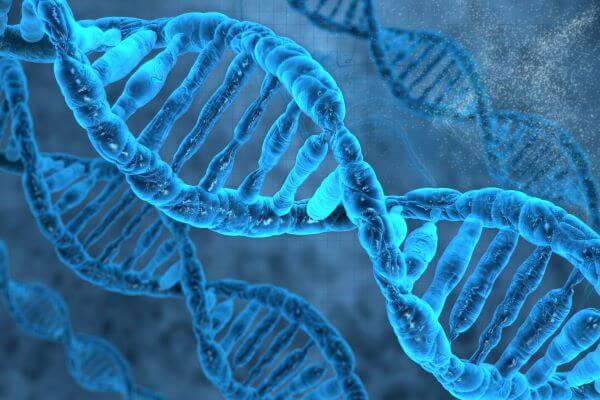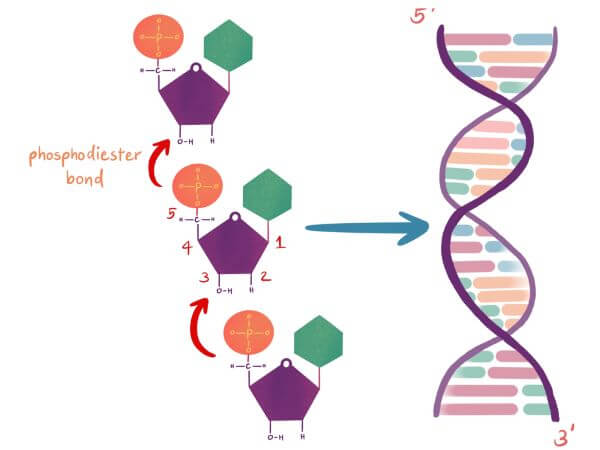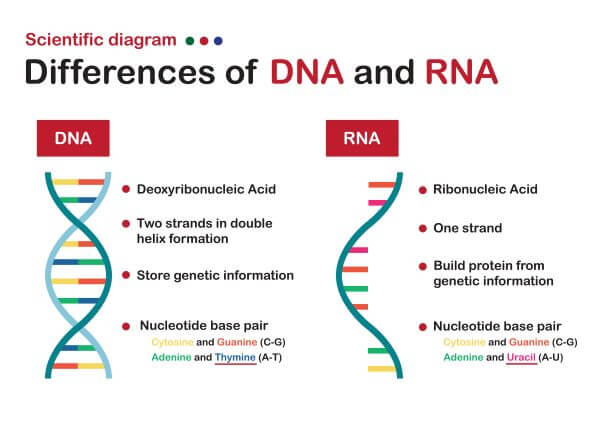DNA (deoxyribonucleic acid) molecules are nucleic acids, which are the information-carrying molecules of the cell. DNA molecules are polymers and are made up of many smaller molecules, called nucleotides. Each nucleotide contains a phosphate group, a sugar molecule, and a nitrogenous base.
DNA molecules consist of two DNA strands, which are twisted around one another to form a spiral shape known as the double helix. The double helix structure of DNA was first discovered in 1953 by James Watson, Francis Crick, and Rosalind Franklin.
DNA molecules are found in the nucleus and store the genetic code; that is, all the information required for an organism to function.

What is the Structure of DNA?
DNA molecules are polymers, which means they are large molecules made up of many smaller molecules. The small molecules that make up DNA are called nucleotides. Each nucleotide contains a phosphate group, a sugar molecule (called deoxyribose), and a nitrogenous base.

There are four types of nitrogenous bases found in DNA molecules. These are:
- Adenine
- Guanine
- Cytosine
- Thymine
The order of the nucleotides in a DNA molecule is known as the DNA sequence or genetic code. The genetic code determines which instructions are encoded in the DNA molecule; for example, how to make a certain type of protein. Nucleotides are strongly linked together by phosphodiester bonds, which form between the 3’ carbon atom of one sugar molecule and the 5’ carbon atom of another.

The nucleotides that make up DNA are joined together like a long string of beads, called a DNA strand. Each DNA molecule contains two DNA strands, which are twisted around one another to make a spiral-like shape called the double helix.
Together, the phosphate groups and sugars form the sugar-phosphate backbone, which makes up the outside of the DNA molecule. The nitrogenous bases point inwards, like the rungs of a ladder, and are joined together in base pairs.
The base pairs of DNA are:
- Adenine-thymine
- Guanine-cytosine

The two strands of the double helix run in opposite directions to one another, meaning that the 5’ end of one strand faces the 3’ end of the other. This is called the antiparallel orientation, and it is essential for successful DNA replication.
Who Discovered the Structure of DNA?
The double helix structure of DNA was first discovered in 1953 by James Watson (an American Biologist), Francis Crick (an English Physicist), and Rosalind Franklin (an English Chemist). Though only Watson and Crick were credited with the discovery of the double helix, they are believed to have made their discovery with the help of Franklin’s data. Franklin was an expert in an imaging technique called X-ray crystallography, which she used to produce the first ever image of the helical shape of DNA.
Watson and Crick were awarded the Nobel Prize for their work in 1962. Despite her contribution to the discovery, Franklin was not awarded the prize, having died of cancer four years earlier.
DNA vs. RNA: What’s the Difference?
DNA and RNA are very similar molecules. Both are types of nucleic acid, both contain genetic information, and both can be found in the nuclei of cells. The structure of RNA nucleotides are also similar to those of DNA; both contain a phosphate group, a sugar molecule, and a nitrogenous base.
However, there are some key differences between DNA and RNA molecules.
Whereas DNA contains deoxyribose, RNA contains a different type of sugar molecule, called ribose. They also contain slightly different nitrogenous bases. Though both DNA and RNA contain adenine, guanine, and cytosine, RNA contains uracil instead of thymine. And, unlike DNA, RNA molecules are usually single-stranded.

DNA and RNA molecules also have slightly different functions.
DNA molecules store the genetic information of a cell, which is used to carry out the functions of the cell. RNA is used to transfer this genetic information from the nucleus to the ribosomes (the cell organelles used to make proteins).
What is DNA Replication?
DNA replication is a process in which two identical DNA replicas are produced from a single DNA molecule. It is an essential part of cell division, which is necessary for the growth and repair of damaged tissues.
DNA replication ensures that each new daughter cell receives a complete copy of the organism’s genetic information. This allows each new cell to function correctly, and the organism to thrive.
